
In the past two decades, education in the United States has undergone a seismic shift in every discipline, moving away from rote learning and towards higher-level thinking and real-world problem-solving. As part of this shift, the way educators evaluate student learning has changed, too. We’re becoming aware of the benefit of performance-based assessments, which require students to apply their knowledge to tasks, activities, and projects with real-world resonance, and grapple with how to apply them at scale.
There has been a lot written on the topic, so in this post, we offer a unique, practical guide for how to fully integrate performance assessment into the classroom. Specifically, we cover the following:
- What are performance assessments and why are they important?
- What do performance assessments look like on state tests?
- How can I prepare students for newly formatted state science tests?
What is a performance assessment?
Performance assessments measure student learning through action: carrying out tasks and activities that demonstrate their knowledge, skills, and abilities. The questions are complex and they:
- Integrate relevant, real-world challenges and problems
- Emphasize deliberate planning
- Require students to reflect on their own process
- Provide hands-on opportunities to demonstrate science knowledge and skills

Performance assessments themselves can take many forms, including:
- Group projects
- Essays and stories
- Presentations
- Experiments and investigations
- Constructed responses

Terminology Call Out
- Performance Assessment: Performance assessment evaluates students by having them demonstrate their knowledge through real-world tasks. They are scored against specific criteria that assess both understanding and practical application of skills. Performance assessments can be designed to solve a problem or demonstrate mastery of a technique.
- Performance Task: A performance task is a specific activity or task students undertake as part of a broader performance assessment framework.
For Example:
A performance assessment might be an acid-base titration experiment, while a performance task for that assessment might be:
- Planning the experiment
- Conducting the lab experiment
- Analyzing data from the experiment
- Creating a lab report
- Presenting findings from the experiment
The performance assessment allows students to demonstrate comprehensive skills through multiple performance tasks.
Why is performance assessment necessary?
Education has shifted towards real-world performance for several reasons:
-
Research has shown that real-world performance is how students learn best.
-
Traditional standardized tests, by contrast, have limitations:
- They offer a scattershot, superficial picture of student knowledge and skills.
- They encourage teachers and students to prepare by mastering the “codes” of the test rather than implementing deep inquiry and exploration into each topic.
- The questions often feel disconnected from what and how students are learning in the classroom.
- They frequently leave test prep feeling like a panicked last-minute “cram.”
-
Performance assessments are authentic and relevant; they give students the hands-on opportunity to apply their learning to real-world scenarios, which is an essential skill for higher education and later life.
-
Performance assessments highlight the best of student thinking and highlight all three dimensions of the Next Generation Science Standards:
- Disciplinary core ideas
- Science and engineering practices
- Cross-cutting concepts
- Many state science tests extensively feature questions that are related to, or even dependent on, performance tasks.
State Tests Are Incorporating Performance Tasks
Because of their well-known benefits, performance assessments are trickling into state tests. This can either be through hands-on tests or, as we’re seeing more and more of, computer-based test questions that ask students to evaluate a performance task that is either about to happen, in progress, or just happened.
Performance tasks on computer-based tests
In recent years, more and more states have adopted computer-based testing, which allows for students to engage in performance-based tasks online and allows for easier scoring, compared to traditional pen-pencil testing. Based on our evaluation of many of these tests, we identified several common question types in which performance tasks are embedded:
- Multiple choice
- Constructed responses
- Technology-enhanced items, including:
- Manipulating variables
- Performing simulations
- Conducting virtual experiments
- Dropdown
The questions themselves may stand alone or—very likely—they will appear in clusters. Question clusters are a group of questions that are centered around a performance assessment related to a phenomenon or study, and they test students on investigating, sensemaking, and critiquing skills. To answer these questions, students are asked to:
- Articulate knowledge of relevant scientific principles
- Apply that knowledge to understand real-world problems
- Engineer and evaluate possible solutions
- Analyze raw data
- Read tables and graphs
- Graph and present data
Let’s look at some examples from real state tests.
Example 1: New York State, 5th Grade
Here is an example of a question cluster from a New York State 5th grade science test (Science, Grade 5, Sampler 4).
Introduction

To begin, students are provided with a scenario about how heat moves in a closed system, including a lab setup of water in a container, both before and after a heat source is applied.
Multiple Choice Question

The first multiple choice question asks students to analyze where they initially observe heat transfer. Note that although this is a multiple choice question, the focus is not on content regurgitation, but rather analysis of a performance task.
Technology-Enhanced (TE) Questions
Technology-enhanced questions incorporate elements of interactivity into student responses, like variable manipulation and virtual experiments. For the next questions in the cluster, students are asked to show their understanding of matter by dragging and dropping smaller models in order to show how the water molecules looked in setup 1 versus setup 2.
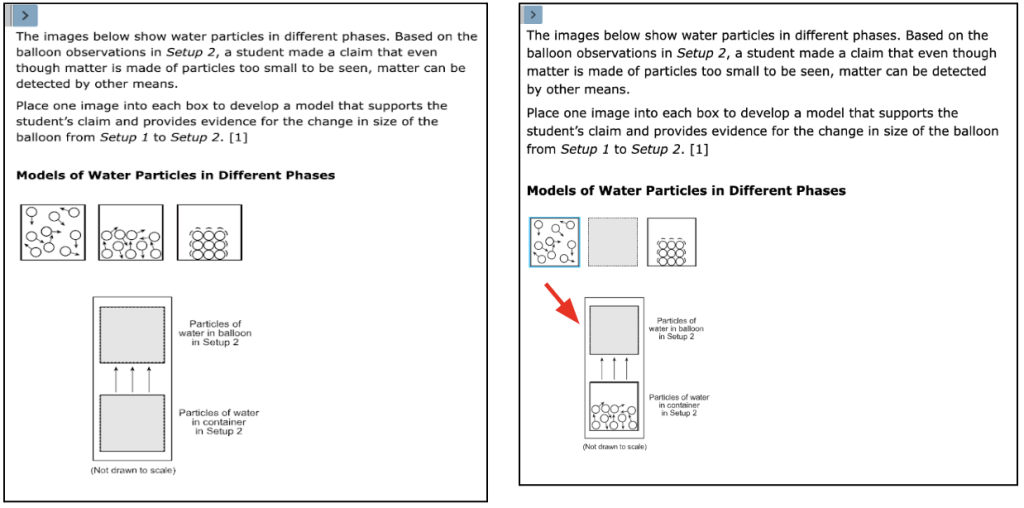
Students then demonstrate their understanding of the conservation of matter by manipulating a bar graph.
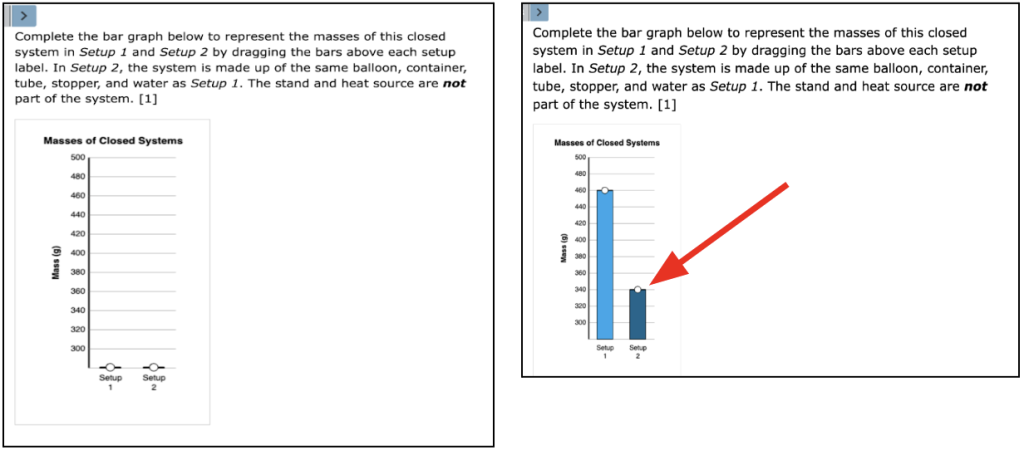
Constructed Response Question
This question presents students with a third state of the lab setup: the same container is now placed into an ice water bath.

The question that follows is an open-ended constructed response question, which requires students to formulate conclusions or make predictions while incorporating evidence into their open-ended response.

Example 2: New Jersey, 8th grade
Here is an example of question clusters from a New Jersey 8th grade science test (Grade 8, Computer Based Unit 2 Tests).
To begin, students are presented with a case study about diamondback terrapins.

Fill-in-the-blank and dropdown
Part A of this question cluster is an open-ended response that requires students to calculate the difference between data presented in two different formats. Part B is a multiple choice question where students must draw conclusions from their own data analysis to choose the answer from a dropdown list.

Multiple Choice Questions
In these multiple choice questions, students synthesize their scientific knowledge of ecosystems and food webs with scenario-specific data in order to draw accurate conclusions. Note that the figures present related data in a variety of formats, and that the second multiple choice question contains two correct answers.
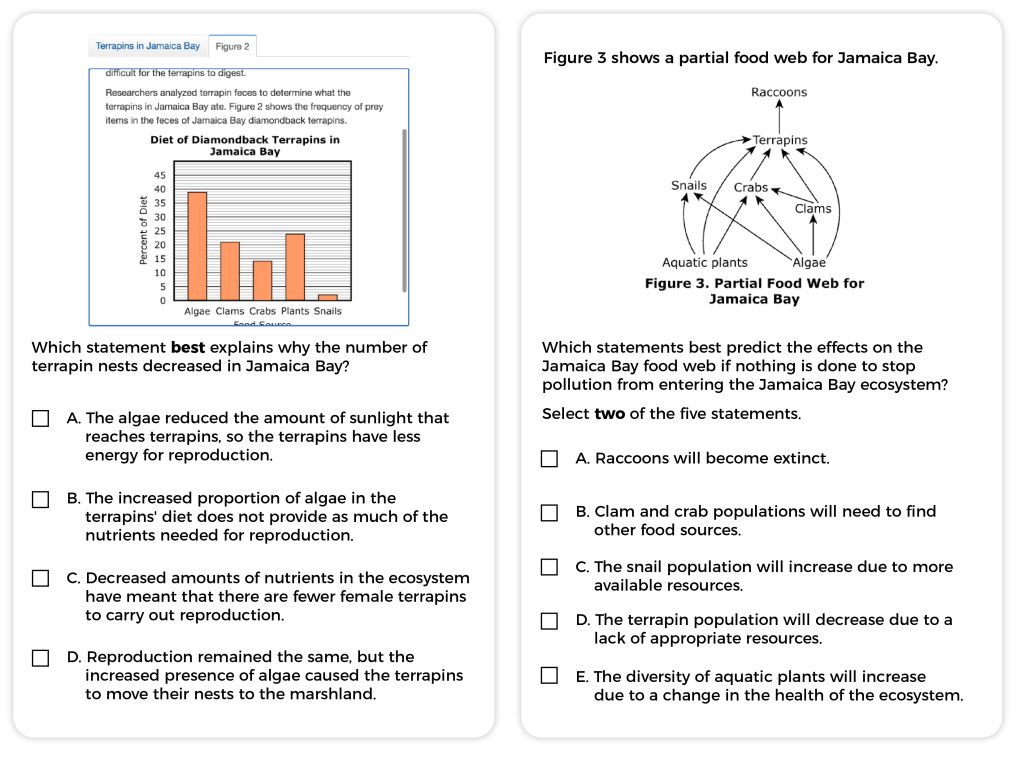
Technology-Enhanced (TE) Questions
In these drag-and-drop questions, students must assess the benefits and concerns of a real-world policy proposal (introducing a non-native algae consumer), applying what they have learned about the scenario so far with their scientific knowledge of ecosystems and food webs.
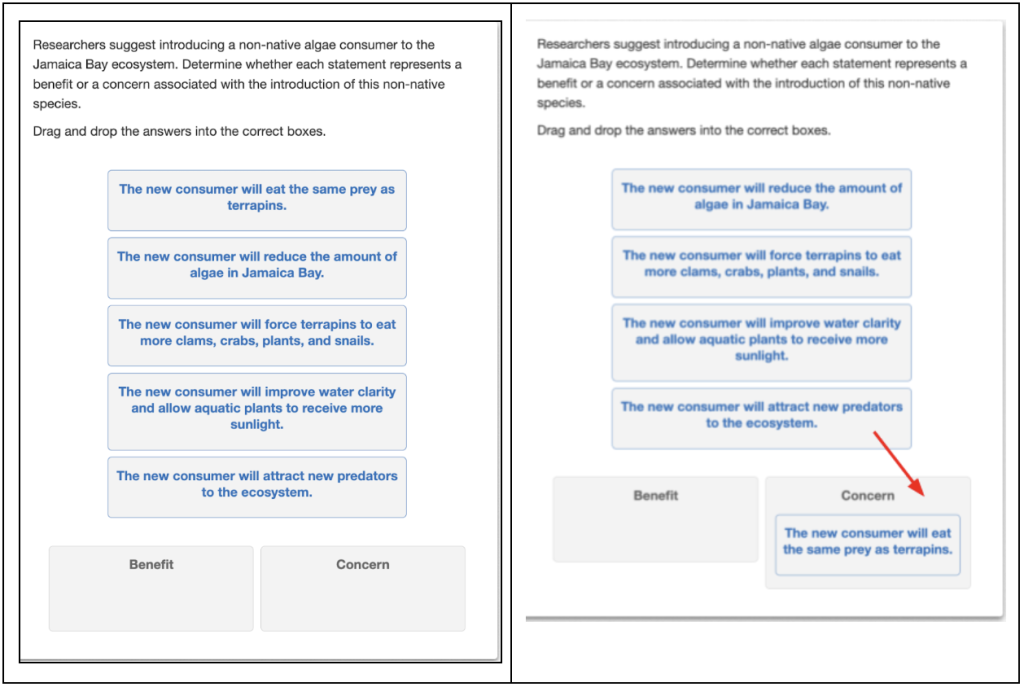
Incorporating performance assessment in class
At first glance, these questions may seem challenging. The answers cannot be placed on the back of a flashcard and “crammed – during testing season” Instead, the best way to prepare students for these question types is by consistently incorporating performance assessments into your lessons throughout the year.
For teachers who are new to performance assessments, it may feel like a big challenge to integrate them. How can we prepare our students for this new state testing format? Below, we recommend how to make your own and how to use Mosa Mack performance assessments:
Mosa Mack Science
Every single Mosa Mack Science unit includes at least 2 authentic assessments to allow students to demonstrate their understanding. Here are a few examples (to learn more, sign up for a free Mosa Mack unit here).
Example: A Performance-Assessment in a Unit on Chemical Reactions
The Mosa Mack Science Atoms & Molecules Lab Extension is a performance assessment for Chemical Reactions and the Law of Conservation of Matter that evaluates students’ understanding of the Law of Conservation of Matter through practical experiments and data analysis. The objective of the performance assessment is for students to experiment, model and collect evidence to validate the Law of Conservation of Matter.
Introduction

Performance Task 1: Conduct an Experiment
Students conduct their own test to recreate the lava lamp experiment.

Performance Task 2: Collect and Analyze Data
Students collect and analyze their own data during their experiment.

Performance Task 3: Create a Model
Students model the chemical reactions, looking at the reactants and how they recombine into products to determine if matter is lost or gained during a chemical reaction.

Performance Task 4: Construct an Explanation
To wrap up the lesson, students must collect and interpret all of their data in order to construct their own explanation and determine which claim is correct.

The checklist at the top assesses whether students have completed their required tasks, as well as whether they’ve done it accurately (i.e. addressed the DCIs.) The rubrics use a set of specific criteria to evaluate student performance. The rubric below measures student performance in four SEPs (science and engineering practices) from the Next Generation Science Standards related to this performance assessment.
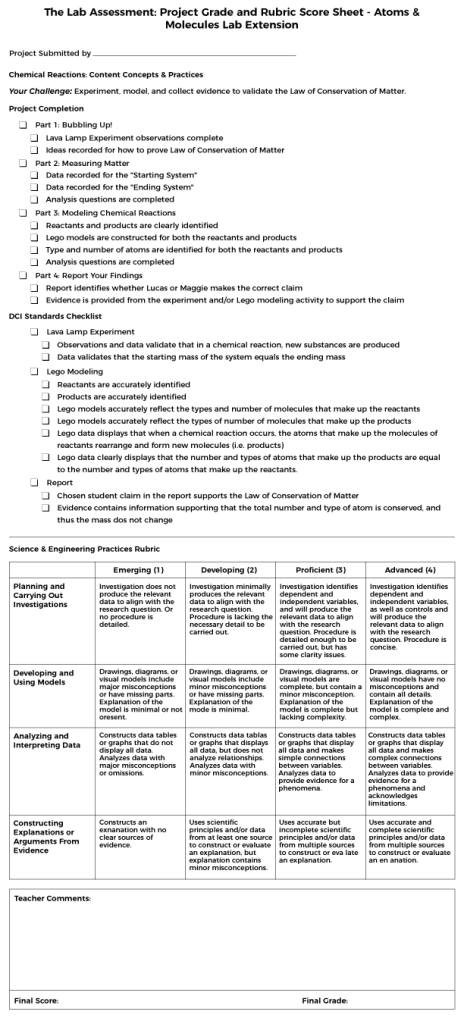
As you can see, a variety of performance tasks are intentionally integrated throughout each unit. This way, students are regularly and consistently reinforcing and expanding their performance skills set throughout the year. What’s more, teachers have a straightforward, objective rubric for assessing performance tasks, so they can accurately measure student progress and easily spot which particular skills or areas of knowledge are in need of improvement.
Create your own performance-based assessment
To help you build your own performance assessments or tweak existing lessons that you’d like to make more performance-based, we created a template to walk you through the process.




How to use it.
Start with the performance assessment you plan on implementing and fill that out in the first box. Next, fill in the Science & Engineering Practices, Disciplinary Core Ideas, and Crosscutting Concepts that the assessment will cover.


Next, determine which types of activities will most authentically measure student performance of the practices, ideas and concepts you are assessing. Then brainstorm and hone your ideas for specific activities for each activity type.
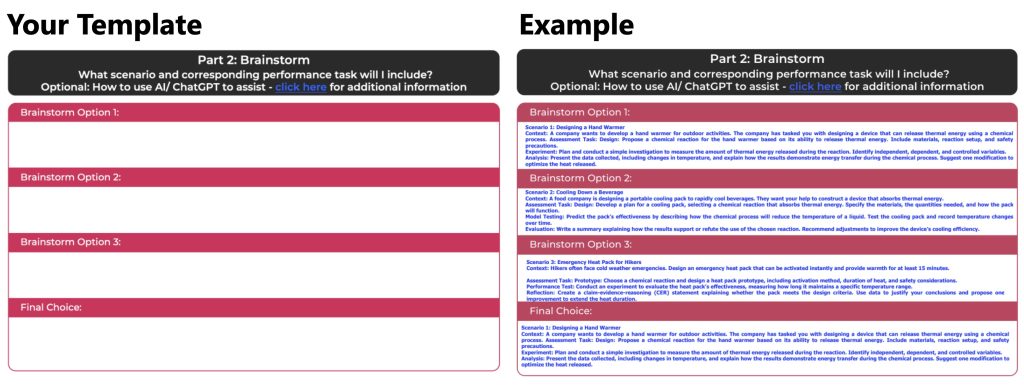
Answer these three planning questions to ensure that the performance assessment is time-efficient, centers student voice and choice, and is centered around a clearly-articulated task.
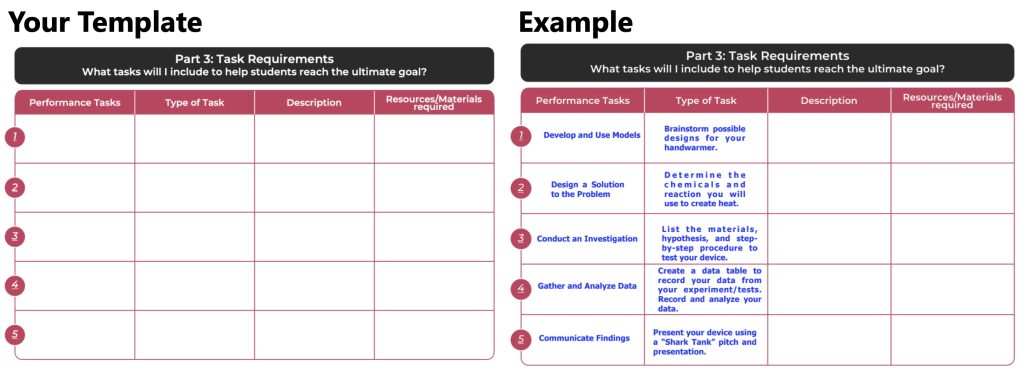
Identify the specific criteria by which you will evaluate the performance task by filling in this form:
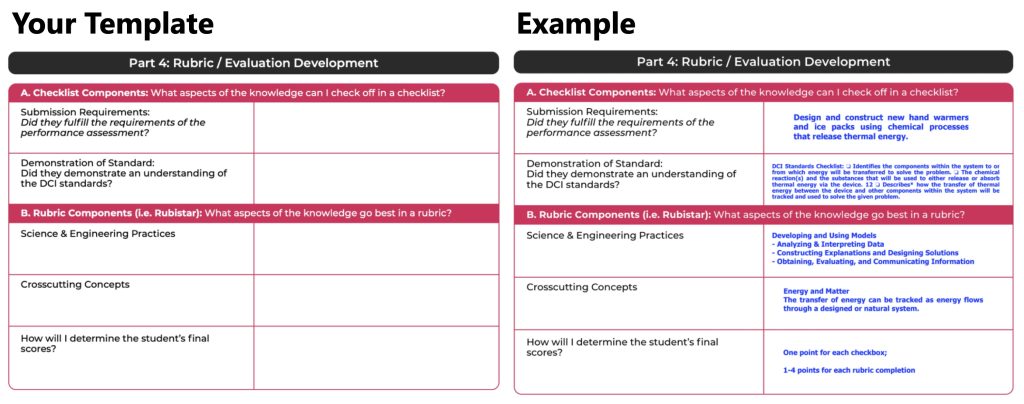
In conclusion, we suggest the following best practices for successfully integrating performance assessments into the classroom:
- Conduct performance assessments multiple times throughout each unit
- Use a variety of types of performance tasks so students have wider familiarity
- Regularly use practice tests from your state and other states, so students are accustomed to the format of performance assessment in tests
- Keep it up! Students may struggle at first, but with regular practice, they are sure to improve throughout the year


Leave a Reply